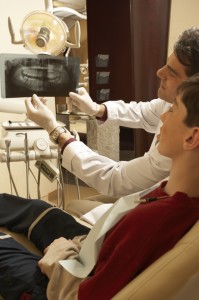 Unfortunately, many diseases of the teeth and surrounding oral tissues cannot be seen by a visual oral exam. An x-ray examination may reveal problems like: areas of decay between the teeth or below existing fillings, infections in the bone, gum disease, extra or congenitally missing permanent teeth, other developmental abnormalities, cysts or tumors in the jaw bone.
Unfortunately, many diseases of the teeth and surrounding oral tissues cannot be seen by a visual oral exam. An x-ray examination may reveal problems like: areas of decay between the teeth or below existing fillings, infections in the bone, gum disease, extra or congenitally missing permanent teeth, other developmental abnormalities, cysts or tumors in the jaw bone.
Finding and treating dental problems at an early stage can save time, money and unnecessary discomfort. Sometimes very small areas of decay can be stopped or reversed with topical fluoride or other preventive substances. How often x-rays should be taken depends on the patients individual health needs, one being the patient's potential risk for decay. In general, children need x-rays more often than adults. This is because their mouths grow and change rapidly and they are more susceptible to tooth decay than adults. The American Academy of Pediatric Dentistry recommends x-ray exams every six months for children with a high-risk of tooth decay. Children with a lower risk of tooth decay require x-rays less frequently.
The safety of x-rays has increased significantly in recent years. With advances in film speed, reduced size of the x-ray beam and getter filters, the amount of radiation is extremely small. In fact, dental x-rays represent a far smaller risk than an undetected and untreated dental problem. In addition, all patients are further protected with lead body and thyroid shields during x-ray examinations. Radiation exposure from dental x-rays 1 to 2 times a year is much less than radiation exposure from natural sources like the sun.

 Patient Login
Patient Login

 Back to top
Back to top Website Powered by Sesame 24-7™
Website Powered by Sesame 24-7™